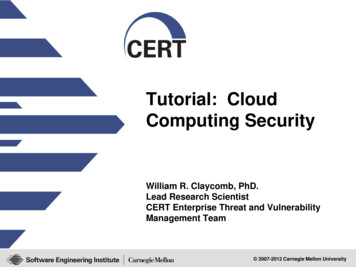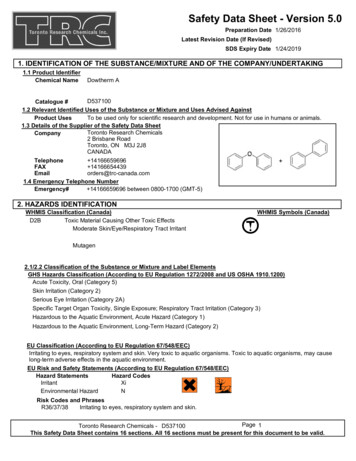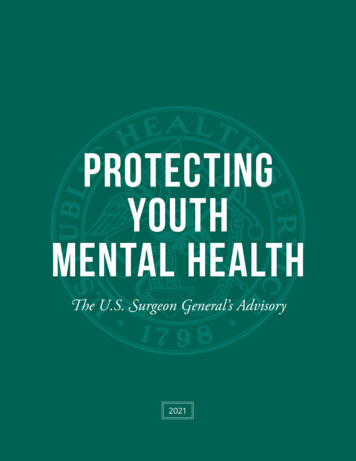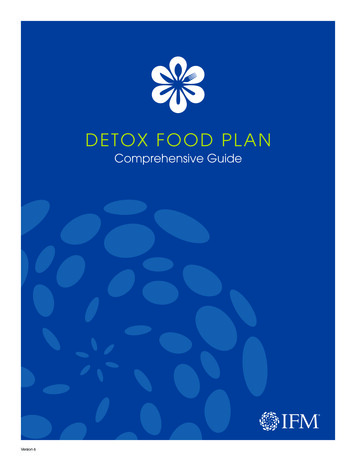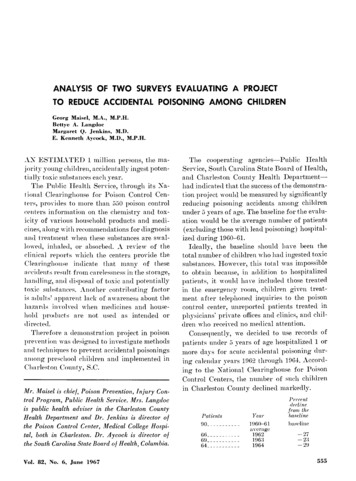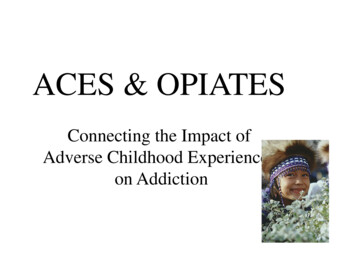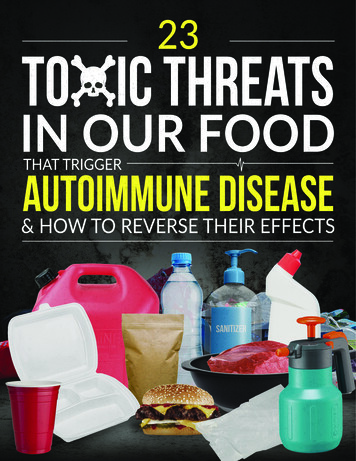
Transcription
23 Toxic Threats in Our Food that TriggerAutoimmune Disease & How to Reverse their EffectsBy: Jonathan OttoCopyright 2021 · Jonathan Otto and Health Secret, LLCNOTICE OF RIGHTS: All rights reserved. Except as permitted under the United States Copyright Act of 1976, no part of thispublication may be reproduced or distributed in any form or by any means, or stored in a database or retrieval system,without the prior written permission of the author.DISCLAIMER: The Author and Publisher have strived to be as accurate and complete as possible in the creation of this book.While all attempts have been made to verify information provided in this publication, the Author and Publisher assumesno responsibility for errors, omissions, or contrary interpretation of the subject matter herein. Any perceived slights ofspecific persons, peoples, or organizations are unintentional. In practical advice books, like anything else in life, there areno guarantees of results. Readers are cautioned to rely on their own judgment about their individual circumstances andto act accordingly. This book is an educational guide that provides general health information. The materials are “as is”and without warranties of any kind either express or implied. The book’s content is not a substitute for direct, personal,professional medical care and diagnosis. None of the protocols (including products and services) mentioned in the bookshould be performed or otherwise used without clearance from your physician or healthcare provider. The informationcontained within is not intended to provide specific physical or mental health advice, or any other advice whatsoever,for any individual or company and should not be relied upon in that regard. While every effort has been made to ensureaccuracy, these contents should not be construed as medical advice, professional diagnosis, opinion, or treatment to youor any other individual, and are not intended as a substitute for medical or professional care or treatment.
TABLE OF CONTENTSIntroduction . iv23 Toxic Threats Linked to Autoimmune and Chronic Diseases . 1Heavy Metals . 1Mold and Mycotoxins . 2Aflatoxins . 3Bisphenol A (BPA) . 4Monosodium Glutamate . 5Aspartame . 6Phenylalanine . 7Pesticides . 8Phthalates . 9Dioxins . 10Glyphosate . 11Silica . 12Iodine . 13Organic Solvents . 14Perfluorooctanoic Acid (PFOA) . 15Triclosan . 16Benzophenones . 17Perchlorate . 18Volatile Organic Compounds (VOCs) . 19Food Additives . 20Endocrine Disruptor Compounds (EDCs) . 21Additives in Pharma Foods . 22Veterinary Drugs in our Food Supply . 23Best Natural Remedies for Getting Rid of Toxins . 24Conclusion . 30About Jonathan Otto . 31References . 32
INTRODUCTIONHippocrates, the father of modern medicine, once said, “Let food be thy medicine.”While this is still true today, much of our food now contains toxic chemicals, genetically modified organisms(GMOs), and pesticides. Not to mention the toxins typically found in our homes in the form of cleaning agents andin our everyday personal care products that add to our total toxic load. While we don’t wish to frighten anyone,we do want to make you aware of the possible dangers so that you can avoid them.Our health is largely determined by what we eat, drink, breathe, and absorb.Our bodies naturally detoxify themselves. The liver, kidneys, skin, digestive system, and lungs all work together torid our bodies of toxic substances. However, when this burden becomes too large, the body starts to malfunction.Toxic overload leads to a host of health issues including leaky gut, inflammation, DNA damage, autoimmunereactivity, and eventually, various autoimmune and chronic diseases.What are toxic substances?There’s a difference between toxins and toxic substances. By definition, toxins are poisonous substances that arebyproducts of the biological processes of a living organism and which cause antibody formation when introducedinto tissues.A toxic substance, however, is any substance that can be poisonous or have negative health effects on the body.Chemicals like dioxin and polychlorinated biphenyls (PCBs) that are often found at hazardous waste sites areamong the most well-known toxins. However, ingredients in daily products like household cleaners, furniture,carpets, gasoline, cosmetics, over-the-counter and prescription drugs, alcohol, pesticides, and sometimes thevery food we eat can be toxic as well.Poisoning occurs when toxic substances are ingested, absorbed by the skin, or inhaled, and cause damage tohealthy tissues. This can occur in small amounts with no adverse effects seen at first but they have a cumulativeeffect over time.What effect do toxins have on the onset of chronic and autoimmune diseases?Chronic diseases are conditions that last a year or more and require ongoing medical attention or that limit dailyactivities or both. Some common chronic diseases include diabetes, neurocognitive disorders, cardiovascular andcerebrovascular disease, metabolic syndrome, cancer, and immune dysfunction like autoimmune diseases.It is impossible to pinpoint an exact cause of every chronic illness, because many factors, either autonomously ortogether, could bring about a disease state. However, it is certain that exposure to toxic substances plays a majorrole in their onset.There are three main ways through which toxins get into the body—ingestion (mainly through food and water),inhalation, and absorption by the skin (through direct contact via clothing, applied substances, air, or water).Some toxins end up being stored in the muscle, fat, bones, or other soft tissues for long periods. Other factorsapart from the concentration of the toxin also contribute to the development of chronic disease. They include theperson’s genetic predisposition, their immune system function, the degree of stress they’re under, their overallnutritional health, and exposure to other chemicals.
This is where the overall body burden comes into play. The term refers to the total amount of toxic chemicals in aperson’s body at any one point in time. It tells us what toxins and chemicals we have progressively been exposedto. The amount of toxins and chemicals found in urine and blood is often transitory — though in some cases theymight be representative of toxins in other tissues and organs of the body.Though it is difficult to determine the exact action of toxins on our health in a simple “cause and effect” formula,an overload of toxins has been observed to often cause: Oxidative stress which plays a big role in the onset and exacerbation of various chronic conditions Endocrine disruption which leads to glucose sensitivity, changed (cell) energy utilization, and alteredneurological development Genotoxicity, which may cause carcinogenesis (cancer formation) or mutagenesis and smaller DNA sequencealterations leading to a state of disease. In a nutshell, this is the development of cancerous diseases. Inhibition or alteration of enzymes that would normally ensure that efficient body processes like metabolismtake place Dysbiosis, which is a disruption of the gut microbiome. This affects many gut functions including detoxificationand proper digestion. These, in turn, may lead to the onset of chronic and autoimmune diseases.Toxins and Autoimmune DiseasesThere are almost 100 known autoimmune diseases, including rheumatoid arthritis, lupus, multiple sclerosis,inflammatory bowel disease, type-1 diabetes, hypothyroidism, and psoriasis. However, there are many otherautoimmune diseases that affect the nervous system, joints and muscles, skin, endocrine gland, and heart.Basically, autoimmune diseases occur when the body’s immune system is attacked by its own tissues insteadof foreign agents like bacteria. The body mistakes its tissues for foreign invaders and sets up an inflammatoryresponse. Increasingly, the incidence of this confusion has been linked to the toxins that abound in our bodies.Autoimmune diseases have tripled in recent decades with 24 million Americans now affected. Factors such asgenetics, a person’s environment, and gender (with 8 out of 10 being women) are certainly contributing factors.Autoimmune diseases affect more women than breast cancer and heart disease combined. They do, however,also affect men and children.The Role of Toxins in Cardiovascular DiseaseCardiovascular disease is an increasing problem worldwide. While many studies have been done on dietary andgenetic causes, the role of toxic substances in the development of obesity-related cardiovascular and metabolicdiseases requires more investigation. Toxic exposure is thought to increase the incidence of cardiovascular diseaseby interfering with thrombosis, thermogenesis, or blood pressure regulation.Drug and toxin exposure in expectant mothers has been associated with cardiac birth defects and the prematureonset of cardiovascular disease in the child.Exposure to heavy metals (like lead, arsenic, aluminum, mercury, nickel, and cadmium), solvents, pollutant gases,and pesticides has been linked to the onset of cardiovascular disease.1 While there’s currently not enough data tosay just how much of a particular metal is enough to cross the safety threshold, researchers are concerned aboutthe cumulative effect of small amounts over a long time. It is suspected that the metals may induce atherogenesis(the hardening and narrowing of the arteries that leads to cardiovascular disease.) Their effect will probably beheightened when a person is genetically susceptible plus has dietary issues as well. While the exact mechanism ofhow heavy metals cause cardiovascular disease is still unclear, there are enough studies to show a link betweenthe two.
Toxicity, Obesity, and Chronic DiseasesThough poor diet and lack of physical activity are key contributors to the obesity epidemic, these factors alone failto account for the rapidity and magnitude of the obesity epidemic. It is interesting that the increased incidenceof obesity in the last forty years mirrors the increase in the use of industrial chemicals. It is believed that thesechemical toxins may play a role in the cause of obesity, particularly those known as endocrine disruptors. Thesesubstances change the normal functioning of hormones.Studies have shown that other chemicals known as “obesogens” adversely affect fat metabolism and the formationof fatty tissue in the body.2Of course, it is well known that overweight or obese adults are more likely to end up with chronic conditions suchas type 2 diabetes, hypertension, osteoarthritis, gynecological issues (like infertility and abnormal menses), heartdisease, and cancers.3
23 TOXIC THREATS LINKED TOAUTOIMMUNE AND CHRONIC DISEASES1. Heavy MetalsAlthough there has been a decline in exposure to heavy metals due to measures such as the banning of leadpaints, for example, they are still present in many homes. For instance, many cosmetics such as lipstick andtalcum powder are potential sources. Heavy metals such as lead, chromium, arsenic, aluminum, mercury, iron,and zinc can also be found in a wide selection of our foods, such as fish, brown rice, and leafy green vegetables.4These metals sometimes occur naturally or are added as ingredients. In some cases they are contaminants. Thepresence of these heavy metals in our foods is more common than we would imagine.Arsenic is one of the most poisonous metals we know of. It is found in two forms — organic and inorganic (thisis the most toxic variety). It enters the food chain as a result of pollution. It has even been found in our drinkingwater. High levels have been found mostly in rice and rice products such as rice crackers, baby cereal, and ricebran. Rice seems to absorb larger quantities of arsenic than other food crops, probably because it requires largeamounts of water to grow in. If the water is contaminated with arsenic, the rice plant will absorb it. White basmatirice from India or Pakistan is safest but brown rice is your healthiest option as it absorbs the least amount of heavymetals plus contains more vitamins and minerals.Mercury is another extremely toxic heavy metal. Fish and shellfish accumulate mercury in their bodies. Fish thatlive for a long time and are higher up the food chain, such as tuna and shark, will accumulate more mercury thansmaller fish. Humans also collect mercury in their flesh from the food they eat, and high levels are toxic. Theycause damage to the central nervous system. Mercury is not only found in the water, but also the air. It can pollutecrops and groundwater. It originates from sources such as oil refineries and cement factories.Lead, another toxic heavy metal, gets into foods via the environment. There may be lead in the soil that getsabsorbed by food crops or settles onto them. There are no safe levels of lead – even small amounts are poisonous.Examination of FDA data showed that 20% of processed baby foods contain lead.5Chromium is necessary for our diet in small amounts buttoo much can be toxic. Chromium particles are presentin the air in the form of dust. These settle on the landand water, binding to the soil. Most human exposureoccurs via toxic waste sites and occupational exposure.Exposure to these metals has been associated with healthconcerns that include reproductive issues, nervoussystem problems, and immune toxicity. This exposurecan intensify the production of reactive oxygen species(ROS) which normally are a byproduct of metabolism.When ROS are overproduced, they cause toxic effects1
associated with different pathologies.6 This includes autoimmune conditions like atherosclerosis, diabetes, cancer,and aging.So, what is one to do? We clearly cannot and should not avoid green leafy vegetables and stop feeding our babies.The easiest way seems to be to avoid those foods proven to contain extremely, consistently high levels of heavymetals. Rice is a big one. Substitute it with cauliflower rice or potatoes where possible. Don’t buy packaged babyrice cereal but rather make home-cooked sorghum or oats porridge or for your little one. Many baby snacks are ricebased so rather go for other options like fresh fruit. When it comes to fish, a vegan diet is highly recommended butif you can’t manage that, avoid the high mercury ones like tuna and swordfish. Also, although plants can absorbtrace amounts of heavy metals from the soil, most are safe. Just make sure you wash them in clean, running waterbefore use to avoid chemical residues. There’s no need to be fearful because it is a simple matter to cut down onyour exposure.2. Mold and MycotoxinsMold and the resultant gasses they produce called mycotoxins can attack both the nervous and immune systems.Researchers believe that they could lead to chronic inflammation which then develops into full-blown autoimmuneconditions such as neuronal autoimmunity, type 1 diabetes, and autoimmune thyroid disease.7A 2017 study conducted in Finland found a significantly elevated incidence of autoimmune conditions in peopleexposed to mold and therefore mycotoxins.8This being said, mold toxicity could lead to a host of other symptoms including muscle aches, fatigue, difficultyconcentrating, digestive issues, and more. This creates an overlap in symptoms the same as those of autoimmuneconditions.Molds occur commonly in homes, especially older houses. They grow in damp areas like basements, ceilings, andwalls. They grow well on paper and wood products as well as under carpets and inside damp upholstery. The bestthing for those with sensitivities to do is remove as much mold from their environment as possible. It may benecessary to have the moldy area professionally treated. Open the windows and doors in good weather to helpthe spaces dry out and be exposed to sunlight.In terms of food, mold is found mainly when food begins to decay. Mold then grows on it and produces mycotoxins.Foods that grow mold easily like bread and fruits should be refrigerated, particularly if you live in a warm, humidclimate. In such climates, it is wise to keep your baking ingredients like flour in the fridge too. Keep food covered toavoid mold spores in the air from contaminating it. Mold is not always visible to the naked eye, so when in doubt,throw it out! Freshness is key here so buy small quantities and eat them fresh or freeze produce for later use.Some people are particularly sensitive to mold and develop nasal congestion, sneezing, or asthma when exposed.Studies have linked mold exposure in infancy to the development of childhood asthma.9 It is believed that for somepeople, mold can trigger or make an inflammatory condition worse. If a person is already immuno-compromised,exposure to molds may very well worsen their condition.2
3. AflatoxinsFollowing on from molds, we need to discuss aflatoxins. Aflatoxins are a group of poisonous substances thatsome fungi produce, especially those found in hot, humid regions. When food is stored improperly, it is likelyto be contaminated by mold and, therefore, aflatoxins. Crops such as sunflower seeds and rice may becomecontaminated by the fungi while still growing in the field, while being harvested and transported, or when beingstored later.Human exposure happens in a few ways. The person may consume a contaminated product directly, they may eatthe meat or dairy product of an animal that has been exposed to it, or they may inhale the aflatoxin-contaminateddust. This often happens to farmworkers during harvest, for example. There are periodic outbreaks of aflatoxincaused illness, especially in developing countries where regulations are not always enforced. For instance, therewas an outbreak of hepatitis in India in 1974 that caused 105 deaths, which was linked to eating contaminatedmaize.10The US CDC (Centers for Disease Control and Prevention) has reported several aflatoxicosis outbreaks since 2004,many occurring in rural Africa when people consumed contaminated maize.11Aflatoxins specifically target the liver and exposure to them has been associated with a higher risk of developingliver cancer.12 13 In hepatitis and cirrhosis patients, tests normally always reveal these toxins. Tests show that thesetoxins are usually always present in cancer patients’ bodies.14 They can also harm the growing fetus and cause anautoimmune response. Toxicity is rarely acute but is usually chronic.15 Aflatoxins also have immunosuppressiveeffects. In children, they reduce the effectiveness of vaccinations, leading to an increased susceptibility toinfection.16Aflatoxins are not destroyed by cooking, so preventing contamination in the first place is essential. Again, freshnessand correct storage is the answer here rather than trying to avoid every food that may become contaminated. Ifpossible, purchase freshly milled flour or grind your own in a home grain milling machine. Check the sell-by dateson goods such as pasta, nuts, and seeds. Once you get them home, store them in the fridge or freezer, particularlyif you live in a hot climate.3
4. Bisphenol A (BPA)Bisphenol A (BPA) is an industrial chemical that is produced in massive quantities. It is used mainly to manufactureplastics and epoxy resins and is commonly found in household plastics such as food containers and water bottles.It is used to harden plastics such as beverage bottles, storage containers, plastic eating utensils, and toys. Epoxyresins are used to line the inside of metal food cans, bottle lids, and water supply piping. Certain dental productsand medical devices may also contain BPA.BPA can easily leach into our drinking water and food — especially when the plastic is exposed to heat. It appearsto cause several immune reactions that contribute to the development of autoimmune disease.17 BPA is thought totrigger autoimmune degeneration of the sheaths that line nerves leading to autism spectrum disorders, multiplesclerosis (MS), neuropathy, and neurodegenerative disorders such as Parkinson’s disease.The amount one is exposed to doesn’t seem to be as significant as an individual’s sensitivity to it. A person mayhave low blood levels of BPA, yet it may still trigger an autoimmune reaction.Most people get exposed to BPAs via their diet when it seeps into the food or beverage from the container. MoreBPA leaches out if the container is heated, such as when we warm up a baby’s bottle in the microwave or leave adrinking water bottle in a hot vehicle.The concern is that exposure to this chemical is becoming more and more widespread. Animal studies show thatbabies and children may be the most susceptible to BPA’s toxic effects. BPA is found throughout our environmentand can be detected in the blood of nearly everyone tested.While it is not possible to totally avoid BPA, you can decrease your exposure to it by following these suggestions: Use glass, ceramic, or stainless steel water bottlesand food storage containers. Never microwave food or beverages in plasticcontainers. Use as few canned products as possible. Look forglass jars of beans, spaghetti sauce, etc. Buy BPA-free baby bottles. Don’t cover food with plastic wrap or store it inplastic bags. Ask your dentist to use BPA-free composites onyour teeth. Follow an anti-inflammatory diet. Use supplements that support immune health.4
5. Monosodium Glutamate (MSG)MSG is a type of excitotoxin. Excitotoxins are acategory of chemicals (commonly amino acids) thatoverstimulate our neuron receptors and taste buds.Many chicken products contain MSG. Thisexcitatory neurotoxin works by overstimulatingneuron receptors in the brain. These receptors aidcommunication between brain cells. Excitotoxinscause them to fire more quickly than usual. If thisprocess goes on for too long, such as if someoneconsumes large amounts of fast foods containingMSG, the neurons can become exhausted andeven die. The over-excited brain cells affect mood,behavior, and can cause headaches. A studypublished in The Journal of Headaches and Painshowed that headaches occurred in 8 out of 14people after ingesting MSG, as opposed to just 2out of 14 people after ingesting a placebo.18Manufacturers add MSG to food to intensify thatsavory umami flavor that’s so popular. Despitepressure from various groups, MSG is still approvedby the FDA in the US. The Standard American Diet— appropriately referred to as SAD — is full ofprocessed foods loaded with additives, includingglutamate. Look out for MSG in bottled saucesand salad dressings, processed chicken products,crackers, crisps, and canned food.There is strong evidence that over-exciting our nerve receptors is harmful to the neurons and certain parts of thebrain. Researchers have long suspected that some people’s fibromyalgia symptoms are worsened by the use offlavor enhancers and sweeteners containing excitotoxins. In 2001, a study published in Annals of Pharmacotherapyreported that the fibromyalgia subjects were mostly free of symptoms after eliminating MSG and aspartame fromtheir diets.19 When they consumed MSG later, their symptoms reappeared. The action of these excitotoxins mayin extreme cases trigger an autoimmune disease such as multiple sclerosis.20Since most processed foods contain excitotoxins, including baby food, eating a whole-food plant-based diet isyour answer to avoiding these harmful chemicals. Preliminary studies have been done on the importance ofvitamin D in this connection.21 This vitamin appears to aid neurons in lowering glutamate toxicity in cells. Makesure you get a little sunshine every day or take a supplement.5
6. AspartameAspartame is another type of excitotoxin that is often added to food and beverages. It is a very popular, pervasiveadditive, particularly in the diet-food industry. That is because it acts as a zero-calorie sweetener. (It is about200 times sweeter than regular sugar.) It is used in many “sugar-free” medicines too such as cough syrups andchewable tablets.The body doesn’t process this type of artificialingredient very well, and it may trigger an immunereaction leading to inflammation and ultimately toautoimmune issuesIn the last ten years or so, many studies have shownaspartame’s adverse health effects. The FDA,however, has continued to approve the substance,citing over a hundred studies that say it is safe undercertain conditions. However, for every study sayingthat aspartame is safe, there are many more thatshow it is not. An article in MDLinx recently reportedmany of aspartame’s negative effects on mood andheadaches — particularly for those suffering frommigraines.22 It has also been linked to stroke andcardiovascular issues, as well as an increased risk ofdementia and epilepsy.23When aspartame is broken down in the body, some of it produces methanol. In recent years, aspartame hasbecome the biggest source of methanol in the American diet.24 Small amounts are harmless and are even producedwhen we eat fruit and vegetables, but larger amounts are toxic because methanol degrades into formaldehyde,which is a carcinogen and neurotoxin.There is a dangerous link between aspartame and autoimmune disease. While causes of auto-immune diseasesare many and multi-faceted, studies such as this one have found a link between diet soda (containing aspartame),metabolic syndrome, and type 2 diabetes.25 In fact, daily consumption of diet soda has been associated with a 36%higher risk of developing metabolic syndrome and a 67% higher risk of developing type 2 diabetes.In animal studies, aspartame has been shown to lead to Hashimoto’s thyroiditis, an autoimmune disease wherethe immune system systematically destroys the thyroid gland, causing it to eventually fail.26 There was even a caseof a woman whose disease was brought on by excessive consumption of artificially sweetened beverages.27 Oncethe sugar substitutes were eliminated from her diet, her antibodies returned to normal levels and the thyroiditisresolved.6
7. PhenylalaninePhenylalanine naturally occurs in many protein-rich foods like milk, eggs, and meat. It is also sold as a dietarysupplement and is a component of aspartame. It is an amino acid and, therefore, is one of the building blocksof proteins. Because phenylalanine can be found in so many food products and medications, the risks of excessconsumption and toxicity are high, which can be especially dangerous for people with phenylketonuria (PKU).Individuals with PKU are unable to process phenylalanine properly. Phenylalanine can cause intellectual disabilities,brain damage, and seizures in people with PKU. There is a blood test available for newborns to detect this if youwant to check.“[P]eople with a rare hereditary disease known as [PKU] have a difficult time metabolizing phenylalanine, acomponent of aspartame, and should control their intake of phenylalanine from all sources, including aspartame.Labels of aspartame-containing foods and beverages must include a statement that informs individuals with PKUthat the product contains phenylalanine,” notes the FDA.28For the rest of us, even healthy people should be aware that large amounts of aspartame can cause a rapidincrease in phenylalanine levels in the brain. Any foods that contain aspartame — discussed in point 6 above —also contain phenylalanine. For instance, artificial sweeteners, including Equal and NutraSweet. It really is best toavoid these altogether an
inflammatory bowel disease, type-1 diabetes, hypothyroidism, and psoriasis. However, there are many other autoimmune diseases that affect the nervous system, joints and muscles, skin, endocrine gland, and heart. Basically, autoimmune diseases occur when the body’s immune system is attac

